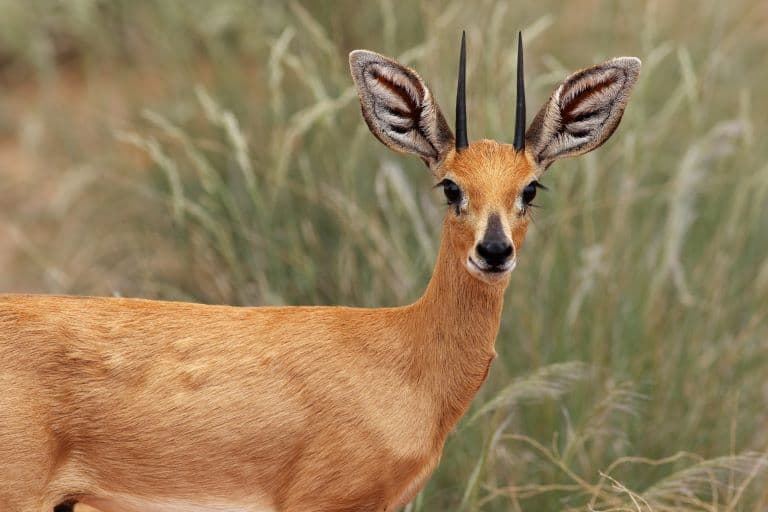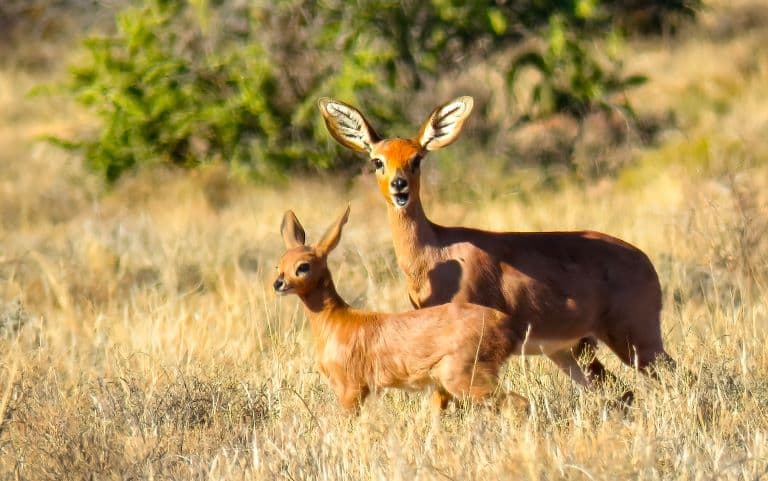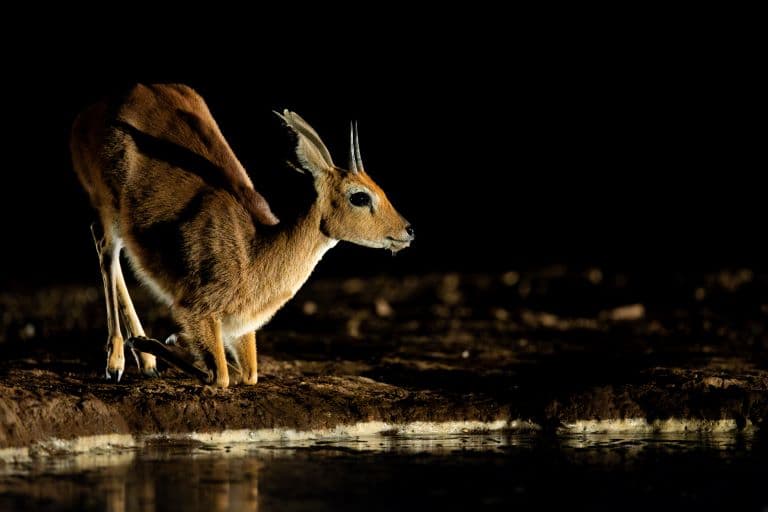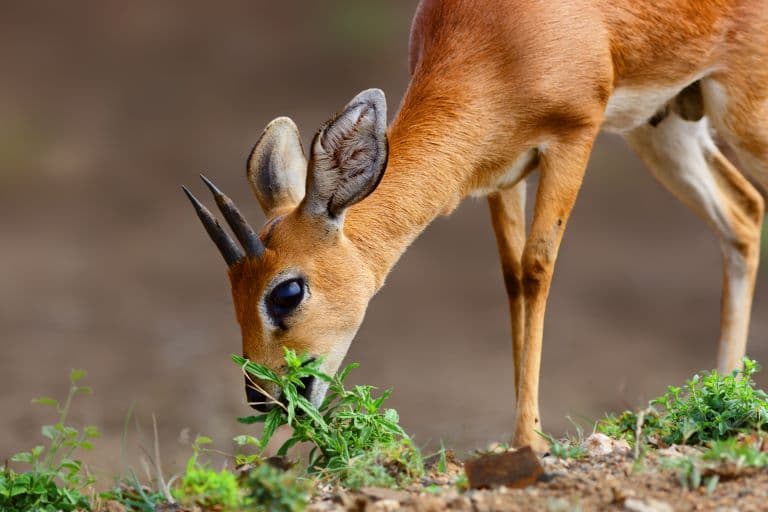Steenbok Profile
In the savanna, sometimes smaller is better, and while all the most frightening predators are distracted with wildebeest and zebra, there’s a whole world of animal interactions happening one level down the trophic ladder.
Steenbok are important inhabitants of this world, and their adaptability, small size and resilience to dehydration have ensured great success for their species.

Steenbok Facts Overview
| Habitat: | Savanna, Shrubland, Grassland |
| Location: | Eastern and Southern Africa |
| Lifespan: | Around 12 years |
| Size: | 60cm (24 inches) at the shoulder |
| Weight: | Up to around 16kg (35 lb), average 12kg (26 lb) |
| Colour: | Sandy brown |
| Diet: | Forbs, woody plants, roots and tubers |
| Predators: | Wildcats, caracal, jackals, leopard, martial eagle, snakes. |
| Top Speed: | Capable of short burst of high speed |
| No. of Species: | 1 |
| Conservation Status: | Least Concern (IUCN) |
Steenbok are very small antelope, feeding selectively on nutrient-dense forbs exposed by grazing herbivores, and capable of incredible feats of water retention.
They’re mostly solitary, skittish and hard to catch, and they’re known to bury their poo, which likely makes them harder to track, too. While they are faced with some threats from human expansion, all in all, they appear to be doing quite well and are spread out across a large portion of the continent.
Interesting Steenbok Facts
1. They’re petite
While not quite as micro as the dik-dik and Royal antelope, this at the same and of the spectrum, usually reaching no more than 12kg and well under a meter tall.
As such, they occupy a lower ecological bracket than some of the larger antelope, both feeding on and being predated upon organisms in this bracket.
As browsers, they pick and choose their meals with more intent than the wider-mouthed grazers, but being so small, they’re limited to anything they can find under 90cm off the ground.
This includes aromatic forbs, fruits, roots, and tubers, the latter of which they dig up by scraping at the ground with their little feet.
These roots provide them with valuable water, and they’re so good at finding it that they don’t need to hydrate any other way. 1

2. Their size has really helped them
Large antelope are always a target for human predation, but this little bovid has survived where others can’t. Second to the Impala, the Steenbok is possibly the most widespread antelope species.
Steenbok occupy a large amount of Southern Africa, and there’s a separated population that takes up a lot of the East. They were once widespread in Uganda, but have been wiped out, though are still highly populous in surrounding Kenya and Tanzania.
They’re solitary, so their small size makes them exceptionally hard to spot, and when startled, are agile enough to escape many predators, too. 2 3
3. They’re nippy
An antelope this size is prey for a lot of the meso- (medium-sized) predators on the savanna. These are animals like wild cats, jackals, and eagles. Steenbok is typically too agile for heavier attackers like lions, though a leopard might have a go if it feels lucky.
When alerted, the steenbok might lie low, crouching like a hare, in a defence strategy known as prostration. If this doesn’t work, it’s a very bouncy animal, pinging off in any direction and running in a zig-zag pattern to throw off its pursuer.
They’re also good at hiding, choosing to plunge into aardvark burrows and small ditches. 4
4. They rarely drink
Another benefit of being small is low water requirements. Steenbok takes this to the extreme, with no apparent need to drink at all.
They will take water where it’s available, but in times of scarcity, they’re able to get all of their hydration from their diet. This is where it pays to be very selective. The roots and tubers they dig up contain large amounts of water, enough for the antelope to survive until the rainy season. 5

5. They’re susceptible to tannins
They spend around a third of the day and over half of the night eating, the rest of the time is spent ruminating (chewing the cud, not pondering their existence, though they may also be doing this), and resting.
Steenbok are very selective with their food, and for good reason, they eat mostly forbs and woody plants, avoiding anything with a high level of tannins.
Tannins are produced by various plants as a useful defence against predation. These are the same molecules that bind with collagen in the manufacturing process to make leather more waterproof and polymerise into long, smooth chains to make wine taste less like rotting fruit.
Inside an animal, this binding ability can make proteins fall out of solution, and cause all kinds of absorption issues in the gut. In one study examining the effects of these tannins on Steenbok, they were shown to cause a 7% reduction in protein digestion and almost 10% in fibre.
This shows a high sensitivity to plant defences in the animals. In fact, in this experiment, the poor subjects rejected the food at first, somehow aware that it wasn’t good for them.
As they’re purely browsers, Steenbok has become very selective with their feeding to avoid items that would give them indigestion. 6
6. They’re tidy poopers
Steenbok are not only picky about what goes in, but they’re also very conscious of where to put their waste.
They appear to be the only antelope to use dugout latrine sites, into which they urinate and defecate, covering up their dung when they’re finished.
Some say this is to cover their scent, but since they immediately get back to scent-marking the earth right after this behaviour, this seems unlikely. 7
7. They’re doing well
Populations in general are regarded as stable, and there are no concerns for the species overall. Domestic dogs do impact small communities, but in general, they’re able to tolerate this.
In Southern Africa, livestock may even provide a benefit to the populations as they appear to prefer heavily grazed areas. They’re also comfortable as high up as 3500 meters, and occupy a diversity of environments, making them relatively adaptable to any location.

Steenbok Fact-File Summary
Scientific Classification
| Kingdom: | Animalia |
| Phylum: | Chordata |
| Class: | Mammalia |
| Order: | Artyodactyla |
| Family: | Bovidae |
| Genus: | Raphicerus |
| Species: | campestris |
Fact Sources & References
- Keagan Chasenski (2023r), “The Diminutive Steenbok: Why do they bury their dung?”, Londolozi.
- WildEarth Djuma Cam (2018), “Djuma: Steenbok digging for gold’en food – 15:28”, Youtube.
- Deon Furstenburg(2008), “Focus on the Steenbok (Raphicerus campestris)”, Research Gate.
- Tayla Brown (2022), “The Secret Life of a Steenbok”, Londolozi Blog.
- O.B. Cloete (1986), “Aspects of the water economy of Steenbok (Raphicerus campestris) in the Namib Desert”, Sabinet.
- JOHAN T. DU TOIT (1993), “The feeding ecology of a very small ruminant, the steenbok (Raphicerus campestris)”, Wiley Online Library.
- Explore Africa (2021), “Ranger Insights | Duiker and Steenbok”, Youtube.
